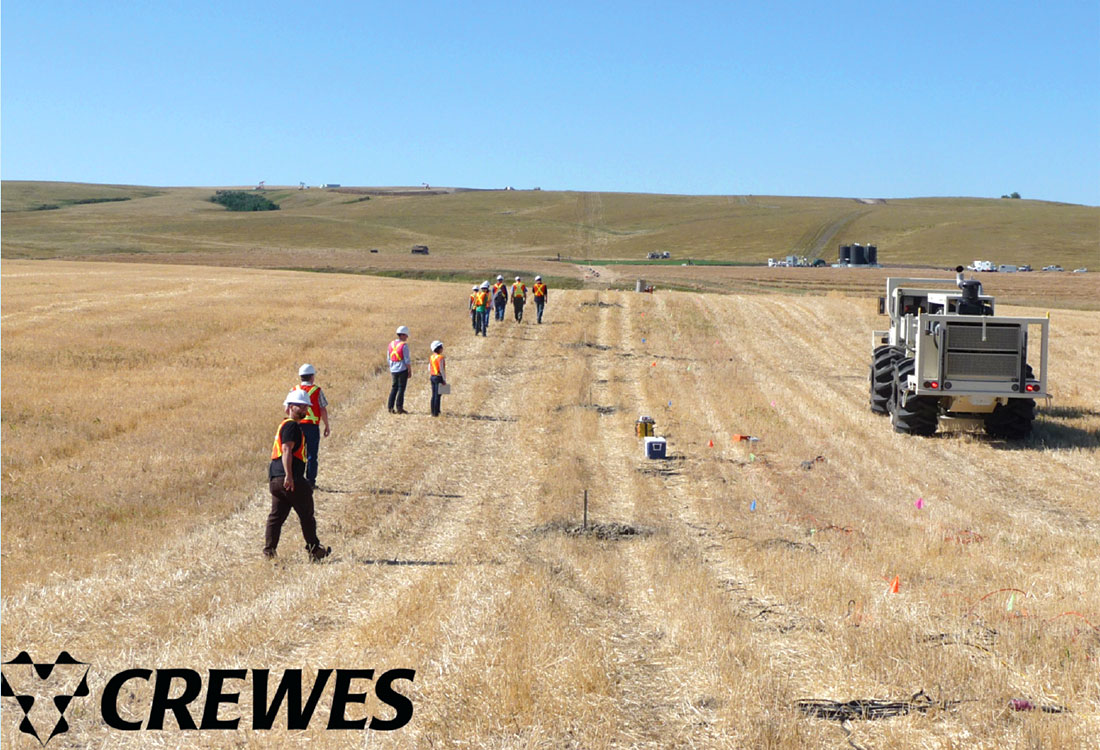
CREWES (Consortium for Research in Elastic Wave Exploration Seismology) is an applied geophysical research group at the University of Calgary that has been focusing on research in seismic data acquisition, its analysis and interpretation of multicomponent seismic data. Founded in 1988 by Professors’ Rob Stewart, Don Lawton and Jim Brown, CREWES has grown into an internationally recognized research group that has produced quality graduate students, many of whom have made a name for themselves in our industry.
As it completes 25 years this year, we all felt it was time to look back at the overall achievements, milestones and the contributions of CREWES. For doing this we sat down with some of the founding and present directors of CREWES, namely Rob Stewart, Don Lawton and Gary Margrave, who are well-known names in our industry. Ms. Laura Baird, the admin manager of the CREWES Project, provided the necessary help in collating the information and coordinating this interview. It was a great experience working with these passionate and energetic individuals, who provided befitting answers to our questions.
Following are excerpts from the interview.
Gentlemen, please tell me all about CREWES, including how the idea of its formation was conceived and the motivation for starting it.
[Rob]: The geophysics program at the University of Calgary began in the late 1970s and was strengthened substantially with the arrival of Don Lawton in 1979 and Jim Brown shortly thereafter in 1980. The program grew with seismologist, Ed Krebes, and the endowment of the Chair in Exploration Geophysics in 1982. This provided much of the foundation upon which CREWES would later be built.
I was a graduate student at MIT working with Profs. Nafi Toksöz and Kei Aki in the early 1980s. Joint university-industry partnerships were developing in the USA with the founding and success of the Stanford Exploration Project and MIT’s logging and seismic consortia. I had the chance to work with several of MIT’s consortia as well as undertake internships at two sponsoring companies (Chevron and ARCO). My experience was very positive about the value of building universityindustry collaborations. On return to Canada, after a postdoc at MIT, I was employed by Chevron Geoscience and then Veritas Software. Veritas supported the Stanford Project along with an ARCO-led consortium on multicomponent seismic recording. So, I had been fortunate to see consortia from several perspectives: The industry needed bright, well educated people along with new ideas and research to enhance resource discovery and recovery. The university needed a network for student hiring, financial support, data, technical counsel, and current problems. After joining the University of Calgary in 1987, my first priority was to set up a Canadian consortium in geophysics. My good colleagues, Don and Jim, were fortunately also ready for this challenge and opportunity.
The industry responded enthusiastically with our call for engagement. In 1988, a remarkable eighteen companies joined our newly minted Consortium for Research in Elastic Wave Exploration Seismology (CREWES – I must admit that the blockbuster movie Top Gun was popular at the time and that influenced our acronym).
Interestingly enough, not everyone at the University was enamoured with the consortium concept. Some worried that academic freedom and research direction would be compromised; others thought the university’s role did not include community outreach and interaction; others yet were concerned about agreements beyond the university. In our experience over the years at CREWES however, we haven’t found that the industry wants to determine the university’s research direction; in fact, the contrary, we’ve found that the industry looks to us to take a lead on many new ideas and concepts. At CREWES, we also believed strongly that the university should have a deep interaction with our professional societies and the geophysical community as a whole. We believe in students developing careers, in addition to taking courses; we aspire to help establish students’ professions, beyond their programs.
We were very fortunate early on to bring Ms. Elizabeth Tillman into the project as our administrative assistant. Liz had an English background and, in addition to being a wonderful person and capable organizer, had one of the most beautiful speaking voices imaginable. We’d often receive calls from sponsors around the world, calling, basically just to talk to her. We were next able to receive the fine benefit of Ms. Louise Forgues’ talents for managing the peripatetic felines (faculty) and students while administering our expanding budgets and reporting requirements. Louise was affectionately known by staff and students as CREWES’ mother. The project was blessed again in being able to recruit the effervescent and efficacious Ms. Laura Baird. Laura continues to keep an enthusiastic and energetic “hand on tiller” in administering the Project.
The Project has relied heavily on the exceptional capabilities of full-time technical staff including former members: Arnim Haase, Henry Bland, Darren Foltinek, Tina Howell, Sue Miller, Zuolin Chen, Jeff Thurston, Colin Potter, Qi Zhang, and Vlad Simin. The thirteen current CREWES staff members constitute a superb team.
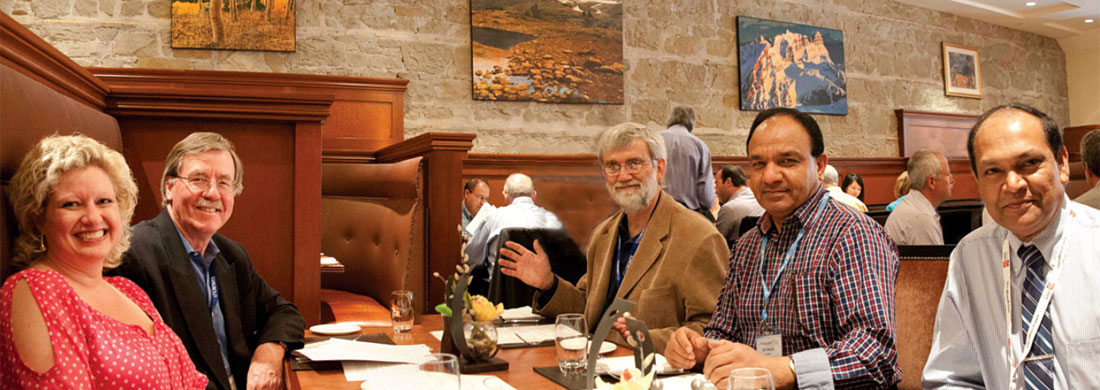
[Don]: CREWES was initiated through the vision of Rob, who came to the UofC in 1988 as the Chair in Exploration Geophysics. The geophysics program at the UofC at the time was growing and we were achieving critical mass with strong enrolments in both the undergraduate and graduate programs. One of the key roles of the Chair was to develop closer interaction between the University and the industrial geophysics community in Calgary. We would be spread too thin to build separate relationships for research and training with every company, so Rob brought forward the brilliant idea of the Consortium model that he had experienced elsewhere. This enabled the UofC geophysics group to interact with a large number of companies under a single umbrella – essentially a subscription model in which each company member would have access to a wide range of research results for a modest yearly fee. With enthusiastic support from key industry colleagues, CREWES was established and is now in its 25th year. Amazing. As Rob has already indicated, the success of CREWES has been realized through the complement of staff members within CREWES over all of these years, as well as the high quality graduate students who have passed through our doors. CREWES is now well-branded internationally and is recognized internationally for its research output and student alumni.
[Gary]: I have been involved in CREWES only since 1995 so the genesis and early years are best left to Rob and Don for comment. Instead, let me speak about CREWES today. CREWES is an acronym for Consortium for Research in Elastic- Wave Exploration Seismology. As the word “Consortium” implies, we are funded by a diverse array of industry sponsors, the Canadian federal government (through NSERC), and with in-kind support (infrastructure) from the University of Calgary. At present CREWES has about 25 industry sponsors, many of which have been sponsors continuously since the beginning. Industry sponsorship is really the life breath of the project and its continuance in spite of the economic fluctuations in the last 25 years is a testament to the very good will in our industry.
The other words in our name refer to the work we do which is, of course, research that is focused on the true nature of seismic waves (elastic waves) and their use in the ongoing exploration of the economic resources of the Earth’s crust. Another key aspect of our work is the training of graduate students in our very complex discipline. We offer an environment that is intimately connected with actual practice as well as being research oriented and this means our students get a uniquely valuable, world-class education.
We have also been fortunate to attract and retain a highly talented professional staff. Many of these people have a great deal of industry experience and all have expertise in one or more aspects of exploration seismology. This includes expertise with data processing, code development, imaging theory and applications, and instrumentation use and maintenance. We are especially grateful to have been able to accumulate a wide array of seismic acquisition gear and, without our technical staff, we would be hard-pressed to use this resource. I should also mention in this context that we have always had a fulltime project administration manager. For 16 years this position was filled by Louise Forgues, who retired in 2008, and since then Laura Baird has filled this essential role. With so many people involved (35 students, 12 staff, several post-docs, and 7-8 associated faculty) this is a challenging job and both ladies have filled it well. Today, the University is a very diverse environment and is evolving towards ever greater administrative complexity. This seems to be driven by an increasing need to monitor the use of public funds. We are especially fortunate to have Laura today as she has proven uniquely capable of managing this complexity.
While industry support is our life breath, our life blood is arguably our cadre of eager and talented graduate students. The majority of our research is accomplished by these students under the direction of their academic supervisors. On average over the last few years, we have about 35 graduate students in residence, about 2/3 of who are pursuing an M.Sc. degree and the rest are pursuing a Ph.D. These people hail from around the globe and many of those of foreign origin have chosen to remain in Canada after leaving CREWES. As someone with over 35 years of perspective in this field, I am gratified and thrilled to see the continual influx of these young scientists.
Those wishing more detail should visit our website at www.crewes.org.
What one or more yardsticks in your mind could be used to measure the success of the CREWES, and how do you think it measures up?
There are many measures of success. But, I would say that the greatest lies with the students who have gone on to wonderful and productive careers – some 132 have graduated from CREWES with M.Sc. and Ph.D. degrees. This amounts to a substantial percentage of the active exploration geophysicists in Canada. These graduates have founded numerous companies, published extensively, led professional societies, received awards, and led discoveries of hundreds of millions of barrels of oil!
On the scientific front, our CREWES Research Reports have captured many of the scientific discoveries and developments of the Project. Over 1,000 technical reports have led to advancements in converted-wave analysis, Gabor deconvolution, VSP, petrophysics, LMR, crosswell imaging, time-lapse assessments, filtering, and new migrations.
CREWES has also acquired some classic 3C data (especially, the Blackfoot 3C-3D data set). These have been distributed to sponsoring companies as well as provided to the geophysical community worldwide via the SEG. The Project has also written definitive software programs that have been released to the world, including the gold-standard Zoeppritz Explorer series. CREWES personnel have always been encouraged to be vocal! One of the greatest CREWES “deliverables” has been the many talks and presentations that faculty, staff, and students have contributed to meetings, courses, and conferences.
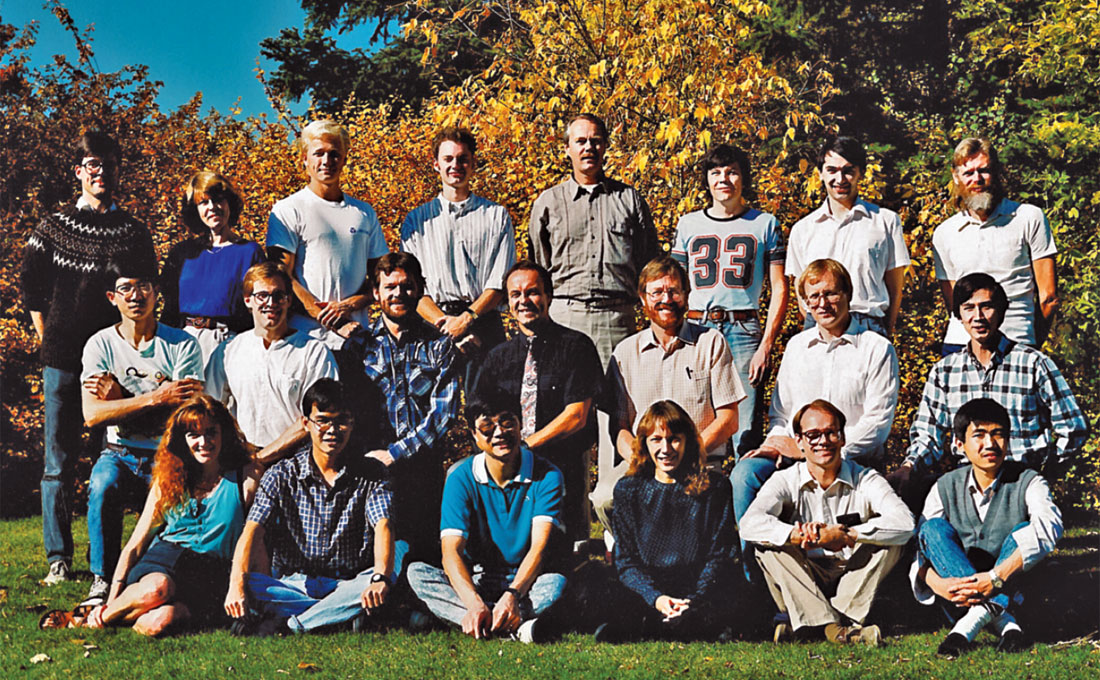
[Don]: Continued industry sponsorship is one metric to assess the success of CREWES. Our sponsors review our contributions on an annual basis, so we always have to be performing at a high level in terms of research output. Another key metric has been continued government funding through the NSERC Collaborative Research and Development Grants Program. We apply for a CRD grant every 5 years and we have been successful for many years in obtaining a significant level of government funding to match industry funding. The high quality of students who have heard about CREWES and want to come to undertake their graduate studies with us from all over the world is another measure of the success of CREWES.
[Gary]: Perhaps the most direct measure of our success has been the continued industrial funding of the project despite the fact that all sponsorship agreements are binding for only a single year. While there has been some fluctuation in sponsorship, this has been in the form of losing a few and gaining a few each year such that we have had funding stability for many years. One thing to add with respect to NSERC is that these grants are not easy to obtain and the application process involves rigorous peer-review plus a site visit by an interrogation committee. That we have maintained financial stability with this relatively fragile funding model is a testament to the quality of our scientific output in the form of papers, HQP (highly qualified personnel), software, and data.

Who have been some of the prominent faculty members or shall I say principal investigators at CREWES?
[Rob]: Bringing in other viewpoints and expertise is a key component of any organization’s health. As multicomponent seismic interest and application grew throughout the community, we were lucky to have Visiting Scientists join us. Drs. Peter Cary and Bob Tatham both took Sabbaticals with us and enhanced our research and teaching.
[Gary]: Initially, this was just three people (Rob Stewart, Don Lawton, and Jim Brown) but today we have, at the University of Calgary, 5 geophysics (Don Lawton, Gary Margrave, Rob Ferguson, Kris Innanen, Larry Lines), one mathematics professor (Michael Lamoureux), and one fulltime staff member who is also an Adjunct Professor (John Bancroft). Further afield, we are fortunate to also have the consistent contributions of Brian Russell and Roy Lindseth from industry and Professor Matt Yedlin from UBC.
[Don]: Gary has covered the main CREWES PI’s over the years. Many of us have also collaborated with Ed Krebes on research that has benefitted CREWES, although Ed has never formally been a member of the CREWES team.
Funding is critical for the success of any Consortium. Tell us about some of the initial challenges you may have faced in putting CREWES on a firm footing. What is its financial status today?
[Rob]: As mentioned before, the initial funding of CREWES was excellent. The big challenge was to live up to the faith that the community had bestowed on us! As the Project grew with students, staff, equipment and overall output, additional funding became more critical. Fortunately, CREWES deliverables had increased and we attracted more than a dozen new private-sector sponsors. After a number of years without publicsector support, we were encouraged to approach the Natural Sciences and Engineering Research Council (NSERC). We did so with proposals for a Collaborative Research and Development grant (where NSERC considers matching industry contributions). After an intensive set of reviews, NSERC generously provided the Project with a major multi-year award. Based on the continuing strong performance of the Project and re-applications, NSERC has continued to provide essential and much-appreciated funds to the Project. Of course, award review and renewal is always an intense period of hyperactivity inside CREWES (like the Annual Sponsors Meeting). One of the challenges CREWES faced, like other organizations, was consolidation in the energy industry. Multiple supporters of research (such as Amoco, ARCO, and BP) merged into one entity.
[Don]: When CREWES was initiated in 1988, we had 19 sponsoring companies. We had an enthusiastic group of companies and CREWES sponsors gradually grew in number. Many sponsors have supported us from day one, for which we are most grateful. It takes a flag-waver in each company to assist us getting support so we are thankful to those many colleagues who have supported us for so long. As Rob mentioned, most of the sponsor attrition has been due to takeovers and mergers, when suddenly two sponsors become one (thus losing one paying sponsor). This has probably been the most stressful part of maintaining the overall sponsorship revenue, but over the past years we have been fortunate in being able to maintain a fairly stable sponsorship level. As indicated earlier, we have also been able to maintain continuous support from NSERC. Every 5 years when we apply for a new NSERC CRD grant, the application process is very rigorous with a full day site visit by a review panel of internationally known geoscientists. The panel also has a closed session with sponsor representatives who provide external input to the value of CREWES.
[Gary]: I will address the present situation. While we have had a consistent sponsorship level for many years, we have gradually raised fees to account for project growth and inflation. Given the complexity of our funding model, any increase in fees involves a great deal of discussion with sponsors and carries the considerable risk of causing nonrenewal, so we always approach this cautiously.
At present, we have a number of fiscal issues whose easy solution has proven elusive. Mostly these have their origin in changes in University governance and operation. Given that we spend almost all of our income on salaries of some sort, this change poses difficult decisions from CREWES leadership.
So, our fiscal situation has always been one of little certainty but we have survived in spite of this, mostly because of the quality of our scientific work. Today we face new and very serious challenges but I am certain that the project will find a way to continue.
What has been the focus of the RESEARCH at CREWES and how has this focus changed over the last 25 years?
[Rob]: Research at CREWES has sought both breakthroughs and incremental improvements. We contributed substantially to the body of multicomponent or fullwave seismic exploration, especially as applied to converted (P-to-S on reflection) waves. CREWES researchers have worked in unusual pursuits such as meteorite impact craters as reservoirs, non-linear wave propagation, salt mine anisotropy, and how innovation comes about in the oil industry.
[Don]: As Implied by its name, CREWES has always had a strong focus on multicomponent seismology. The late 1980’s saw a strong industry push towards using elastic waves and measuring the full vector wavefield. Many groups used pure-mode approaches including P-wave and Swave sources. CREWES was one of early pioneers of recording converted waves, in which P-wave sources are used with 3-component receivers. Multicomponent seismology is still a core focus but CREWES research output and algorithms now include a broad range of applications in both acoustic and elastic seismology.
[Gary]: We have always addressed the full spectrum of exploration seismology from acquisition through data processing and imaging through to inversion and interpretation. We have progressed steadily in our seismic gear and today have a 600 channel Aries system, an Envirovibe, lots of geophones of various types and other gear. We like to use this stuff to collect unique data that addresses research issues. We have always preferred multicomponent acquisition but we do collect and analyze single component as well. In 1995 we collected the Blackfoot 3C-3D survey, one of the first of its kind, and recently collected the Hussar low-frequency dataset. We try to do one or two field experiments each year.
We like to develop algorithms and have had a number of notable successes especially in imaging and deconvolution. Early on, we developed the first converted-wave processing algorithms and these are now routinely found worldwide. Like others worldwide, we focused on kinematics of imaging through the 90’s and have been working toward better inversions in recent years. As a group, we are presently very excited about the potential for full waveform inversion especially in the elastic case.

How does CREWES compare with some of the other consortia in Europe and North America?
[Rob]: It’s tricky to self-assess. But, probably the best evidence of comparative quality of consortia is whether companies sign up and pay again! We actually designed CREWES sponsorship to be annual, so that we had to perform and deliver every year. If not, companies could opt out. One of the very good things about private-sector funding is that the funders are also the users. So, there’s direct relationship between the usefulness of results and support. We have attempted to quantify CREWES’ impact (please see Thurston et al., 2005) and compare its deliverables to other consortia. We found that, according to various metrics, CREWES was performing as well or better than leading American and European consortia.
[Don]: Anecdotally by our sponsors we have been compared to other consortia groups that Gary mentions. A few years ago when Larry Lines was Editor of Geophysics, he compiled lists of publications in Geophysics, TLE and SEG expanded abstracts and CREWES came out very well on a comparative basis.
[Gary]: I think we compare very favorably with the top few in the world (e.g. Stanford, Mines, Delft) but each group has its strengths. We are strong in many areas but standout perhaps in our ability to conduct our own sophisticated field experiments. I’m confident that we have a global profile in exploration seismology and we intend to keep that.
Has this focus of research been commensurate with the expectation of the member sponsors?
[Rob]: CREWES regularly surveys its supporting companies, attendance at SEG sessions, topics of research workshops, and other interest indicators. On these bases, and consistent with our own expertise, vision, and external opportunities, we develop research projects. Sponsors can initiate projects too, as well as respond to these developments throughout the year. Because the Project has so many participants, it can handle a wide variety of investigations. There’s generally something for everyone.
[Don]: Each year at the sponsor’s meeting, we have a meeting with our Industry Advisory Board and present the main research directions for the following year. The Board has always provided sound advice but our sponsors have never been particularly prescriptive on what we should or should not be undertaking research on. In addition, we circulate a questionnaire to all sponsor representatives and ask for feedback on a comprehensive list of research topics. We always find that multicomponent seismology strongly underpins research expectations, but these also carry over into applications of vector wavefields, particularly in topics such as fracture characterization.
[Gary]: We try to be in continual communication with sponsors about their technical needs and definitely have evolved our research agenda to address as many of these as we can. While we cannot do everything, we make every effort to do useful research and the fact that we continue to retain and attract sponsors seems to indicate that we do this well.
Who have been some of the long term sponsors of CREWES?
[Gary]: Chevron, Husky and Shell have been with us since our inception. Three other sponsors have also been with us since the beginning, but they all started under a different company(s) name: Landmark Graphics (originally a sponsor under Advanced Geophysical Corporation), ConocoPhillips (originally a sponsor under Phillips Petroleum Resources Limited), and ExxonMobil Corporation (originally a sponsor under Imperial Resources and Mobil Oil Canada).
Over the years we have also enjoyed long term sponsorship relationships with BP, Devon Canada, EnCana, Marathon Oil, Petro-Canada, Petrobras, Saudi Aramco and Sensor Geophysical. Unfortunately a few of these sponsors are no longer with us but we cherish the relationships we formed and are very proud to have worked with all of them.
How has the adoption of new technology at CREWES changed over the years and how has this benefitted the students?
[Rob]: The CREWES technology journey has been similar to that of the geophysical industry (from floppies to thumb drives, big iron to iPads, …). We started with an IBM installation running Western’s seismic processing software – just powering the machine required a rewiring of our computer center with new cables and an additional transformer. Now, we see four big changes underway: technically, the move to nodal acquisition and full-elastic inversion; educationally, the transition to online/blended courses and training for the great crew change.
[Don]: One of CREWES’ strengths has been our capability to undertake field research projects, including acquisition of seismic data. In conjunction with the University of Calgary, we were fortunate in being able to acquire a 600-channel seismic recording system and an Envirovibe in 2006 which have enabled us to undertake many innovative experiments. We have been very well supported by donated software licenses that keep us current with industry. This creates a leading-edge learning environment for our students. Computer hardware has also become less costly over the life of CREWES. We used to have expensive graphics machines but now these are much cheaper and we have excellent computer resources on every student’s desk.
[Gary]: Perhaps the most obvious changes have been in the nature of computation and the digital analysis and interpretation of data. We have spent considerable resources keeping upto- date in both hardware and software. In the latter case, we are fortunate to have much donated industry software, most especially the Landmark products and Vista from GEDCO.
We have also seen a lot of change in seismic acquisition technology. Back in the 90’s multicomponent acquisition was a cabling nightmare requiring a separate cable for each component. We led the way in developing a 3C cable and connectors and today everyone uses that. We now have a modern cabled system just as the industry seems to be transitioning to nodes. This constant improvement in acquisition is one of the things that keeps our work interesting.
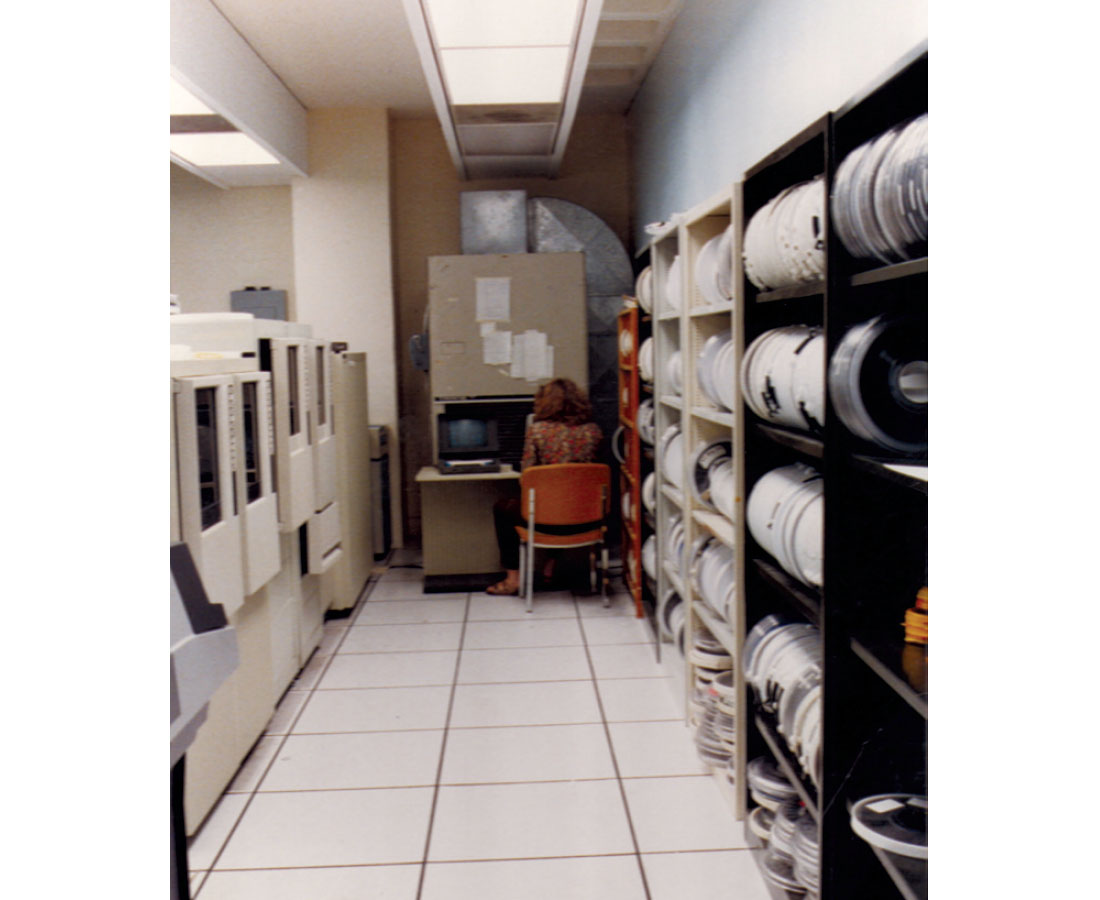
The R & D at CREWES is structured about the M.Sc. and Ph.D. work for the students. How many students have completed their thesis at CREWES in the last 25 years?
[Gary]: We have had many wonderful students complete their degrees with CREWES over the past 25 years. At last count, we have had 100 Masters students and 35 Ph.D. students complete their programs with us, and we anticipate another 3 – 5 students to defend before September 2013. Many of these students are just starting out and are at the beginning of their careers, but others were what would be called “mature students” (Brian Russell, Jon Downton, Hugh Geiger), and they are an inspiration to everyone.
What are some of the focal areas now being pursued at CREWES?
[Don]: Continuing to undertake field experiments remains a key focus for CREWES. We are in the final stages of building an S-wave accelerated weight drop source that we plan to use in surface seismic and vertical seismic profile experiments to better understand the scattering and attenuation of S-waves in the nearsurface, with the goal of understanding why the bandwidth of converted waves in land data tends to be rather low. We have also recently purchased some fibre-optic accelerometers which we will be deploying in shallow boreholes. There is a lot of interest in industry on fibre-optic sensing technology, particularly for well-based recording. We look forward to contributing to knowledge in this field. Another facility that we have is a physical modelling system that Joe Wong has been developing and running for us for many years now. This is a sophisticated laboratory facility that is contribution to some core research areas such as anisotropy, fractures etc.
[Gary]: We are pursuing techniques that can enhance the bandwidth of our data and that can improve its inversion for the estimation of earth properties. Here we can exploit our diversity and address new ideas in acquisition, modelling, processing, imaging, and inversion, all with the goal of improving bandwidth and hence resolution. We are very committed to methods that offer lithology and fluid discrimination which is a major reason that we prefer multicomponent data where possible. We are very interested in full waveform inversion and see this as a natural generalization of current imaging and inversion methods.
How about the characterization of the unconventional reservoirs? I understand another consortium for heavy oil, CHORUS, exists in the Department of Geosciences, U of C, but how about the shale resource characterization, especially because the Horn River, the Montney and Bakken shale plays are hot plays in Canada these days?
[Don]: We have undertaken some studies of imaging and characterization of shale gas plays, mostly through analysis and interpretation of multicomponent seismic data that has been provided to us for such studies. Our research has focussed on attribute analysis, fracture analysis and interval Vp/Vs analysis. These are subtle effects and we look forward to continuing this line of research. One difficulty that we have is accessing production information from the producing wells to integrate with seismic predictions – it is hard for us to get this type of information.
Has CREWES been awarded any recognition by the SEG, which would be a validation of the quality of the work done here?
[Gary]: Yes, and perhaps awards are another metric we could have mentioned earlier. We received the Distinguished Achievement Award from the SEG in 2003, which was an amazing honour. We have also been awarded APEGGA’s “Achievement Award” in 1993 and NSERC and The Conference Board of Canada’s “Synergy Award” in 1999. It is always gratifying to be recognized for the research we conduct, and we are very proud and honoured to have received these awards.
What has been the record of employment for students who received CREWES support during the last 25 years?
[Gary]: Almost all of our graduates have found employment in the industry and many are in influential roles. Over 90% of our students find jobs with our industry sponsors, which is a testament to the close relationship we have with our sponsors. A few graduates have found academic positions and two (Rob Ferguson and Dave Eaton) have even come back to the University of Calgary as professors.
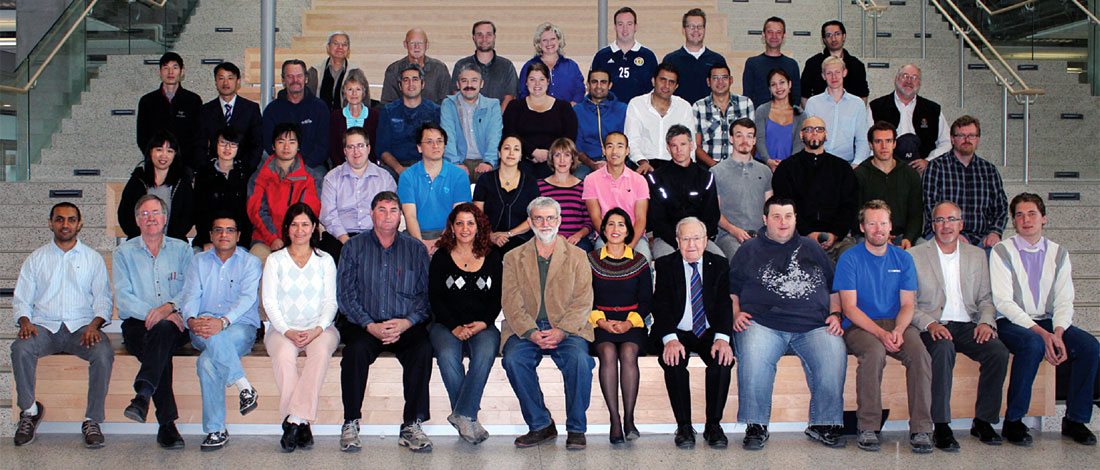
Going forward, what vision for CREWES are you working towards?
[Don]: I would like to see us keep a strong focus on multicomponent seismology. We are planning several field experiments to better understand the PS bandwidth issue and Swave statics and attenuation. We are hearing that multicomponent data are being recorded, but that the horizontal component data gets ‘parked’ and only the vertical component data gets processed. We would like to change that mindset so that the full vector wavefield gets processed routinely. I think this is starting to happen more frequently in oilsands timelapse datasets and we might project that multicomponent data may be potentially more interesting in a timelapse application rather than for primary imaging.
[Gary]: I hope to see CREWES continue to play a positive role in the worldwide advancement of seismic imaging. In concert with this, I hope to see us continue to offer a quality research environment where students can obtain a uniquely valuable experience while gaining the skills they need to contribute to our industry. We are very committed to addressing the problems on the leading edge of industry interest and to working with our sponsors in all aspects of seismic exploration.
You have been the principal investigators at CREWES for the last so many years. Looking back at all these 25 years how does it feel? Is it a sense of fulfillment, satisfaction, or anything else?
[Rob]: CREWES was my full-time professional home for 21 years. I always believed whole-heartedly in its mission and practice of helping educate students and pushing the frontiers of subsurface imaging. Partially because CREWES was inside the University, we were able to establish a nurturing research and educational environment that could tackle longer-term problems and more patiently assist in developing new (and returning) geophysicists. Outside of the university, the geophysical community has been filled with supportive colleagues and generous friends. So, it’s with a sense of deep fulfillment (and considerable nostalgia) that I view the last 25 years of CREWES.
[Don]: There is a great sense of satisfaction about what CREWES has accomplished over these 25 years. I’m the only one of the 3 founding members still active in CREWES (Rob and Jim were the other 2), so maybe it’s time for me to go too! However, there are still many interesting and challenging topics to research. One of the greatest senses of fulfillment is to see the successful career paths of our graduates and many have risen to senior positions in companies or have started their own successful enterprises.
[Gary]: Sometimes being part of CREWES is like having the proverbial “tiger by its tail”. The project often seems to have a life of its own and we all feel driven to keep pace with the demands of the annual schedule. Yet, when there is a chance to pause and look back, I realize that this is a very good thing and I am indeed proud to be a part of it. It is gratifying to see so many former CREWES students filling influential roles in industry and academia. I also feel very fortunate to be able to work on a problem that is both intellectually fascinating and also economically important.
Do you think there is enough emphasis on interdisciplinary research in the work carried out at CREWES?
[Rob]: The sparks of discovery often spring from touching two different lines of practice. Likewise, the solution to problems will likely arise from multiple approaches. Naturally, this is difficult: different disciplines have their own language, personalities, rewards, skills, etc. Nonetheless, applied geophysics is a hybrid field and so must connect with geology, physics, engineering, computing, and mathematics. CREWES has made excellent connections with many of these fields (via joint programs, cross-supervision of students, and collaborative studies). It’s clear though that as new problems and opportunities emerge, it’s incumbent on us to develop further interdisciplinary ventures.
[Don]: Over the years CREWES has remained fairly focused on exploration geophysics topics and our sponsors have encouraged us to stay on this path. In my own case, I have always enjoyed interpretation aspects of seismic data and many of my students have successfully been able to include processing and interpretation components in their theses. In recent years, there has been a drive towards integration of geophysics and rock mechanics, particularly for shale gas, oilsands and enhanced oil recovery studies. CREWES projects have undertaken research into rock properties deduced from seismic data, but have not ventured much into making our own laboratory measurements. It is preferable to collaborate with researchers elsewhere for these data, such as Doug Schmitt at the UofA.
[Gary]: In my particular case, while I’ve focused on geophysics it is with a mathematical perspective. This has motivated me to seek the involvement of the mathematical community. For example, I’ve been fortunate to have collaborated with Michael Lamoureux for much of my time at CREWES and his insight into mathematical methods has led to some exciting work, including Gabor decon. We have tried to bring both mathematics and physics students into our graduate program and there have been a number of outstanding people in this regard.
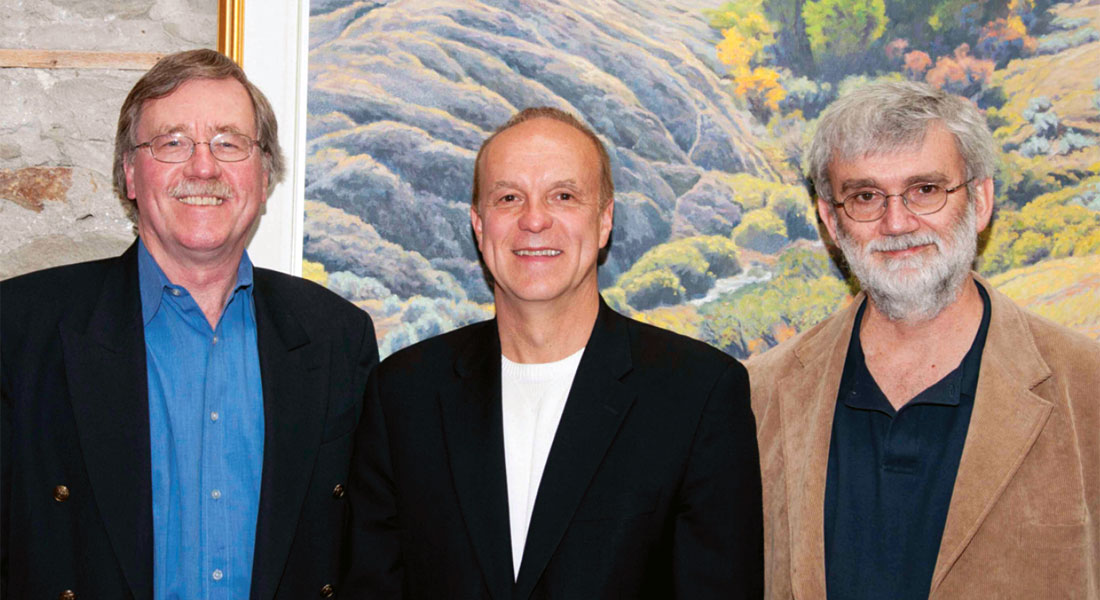
While every piece of research work is important, what do you think was the most important contribution and important piece of work that rolled out of CREWES?
[Rob]: I think that a major contribution of CREWES was the development of a university-industry structure that linked the professional and academic communities together for the considerable benefit of all. On the technical front, one of the biggest revolutions in subsurface imaging was, of course, 3D analysis. CREWES went after the next big dimensions: 3/4C, 4D, and depth. We investigated many dozens of aspects of elastic waves from their measurement, through processing, imaging, and interpretation. Some of our most cited work, according to Google Scholar, is related to nonstationary signal analysis, converted-wave seismic exploration, tomography, and inversion. Releasing seismic data, computer programs, and PowerPoint presentations through the SEG and our websites has had a very broad impact.
[Gary]: We have done so many things, I hesitate to single out one as most significant because that is simply a personal value judgment. However, I will mention our pioneering development of the essential convertedwave processing algorithms, our work in the development and testing of multicomponent acquisition techniques and instruments, our invention of several new algorithms (like Equivalent Offset Migration and Gabor deconvolution), our investigation and improvement of other algorithms (like radial filtering), our pioneering work in PP-PS joint inversion and interpretation, and many other things. You have to expect this would be a difficult question given the size and longevity of CREWES.
Can we expect any significant breakthroughs out of CREWES in the next little while?
[Rob]: Massive and continuously recording nodal systems are opening up whole new realms of acquisition. And while the nodes are deployed, it makes sense to have them record as much as possible (3/4C, gravity? EM?). Repeatedly simulating the full seismic wavefield and inverting for reservoir properties and their changes is an exciting trend. Understanding and teasing out the critical attributes for unconventional resources is a challenge. We’re working hard making advancements in all of these areas.
[Don]: We sure hope so!
[Gary]: We are pushing forward on a number of fronts including fullwaveform inversion, multiple elimination, bandwidth expansion, multicomponent interpretation, fracture detection, construction of sophisticated synthetic seismograms, seismic attenuation (Q), and many more.
With the changing times, the fundamental scientific research which was earlier carried out in many oil companies is now outsourced to Universities. What fundamental research has been done at CREWES? Has this led to a greater collaboration between the industry and the academic community?
[Don]: I believe that CREWES has made many fundamental contributions to geophysics over its history. Developing converted-wave seismology through acquisition, processing and interpretation has had both fundamental and applied components (often the two are hard to separate). One advantage of the consortium model is that some research projects have taken several years to produce results while others are more short-term. The key is balanced research portfolios so that company representatives can see useful contributions yearly in order to sustain sponsorship, while realizing other topics have to be developed over much longer time-frames.
[Gary]: I’ve already elaborated at length on the types of research done at CREWES. I think CREWES does fit well into a changing research environment that was formerly dominated by major oil companies. It is interesting to note that we have, on several occasions, hired retiring scientists from such companies (for example Dave Henley from Shell and Peter Manning from Mobil) and these people continue to contribute strongly to our work. In this way, CREWES has provided a mechanism whereby such talented scientists can contribute to the training of future researchers and thereby pass on some of their accumulated knowledge. In my own case, after 15 years at Chevron, CREWES provided me with a nonstandard path into academic research, a transition that would otherwise have been much more difficult if not impossible. So, not only does CREWES train students and other academics for a role in industry, it also facilitates people moving the other way. I think this is a very valuable role for CREWES to play.
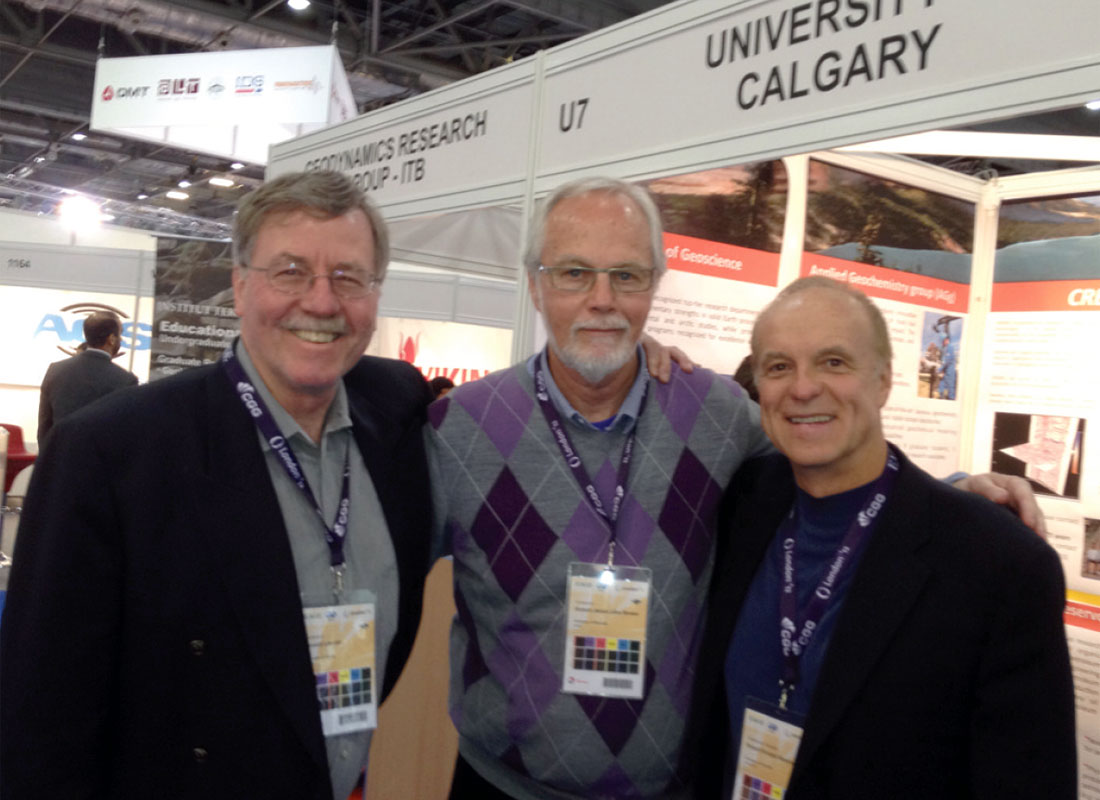
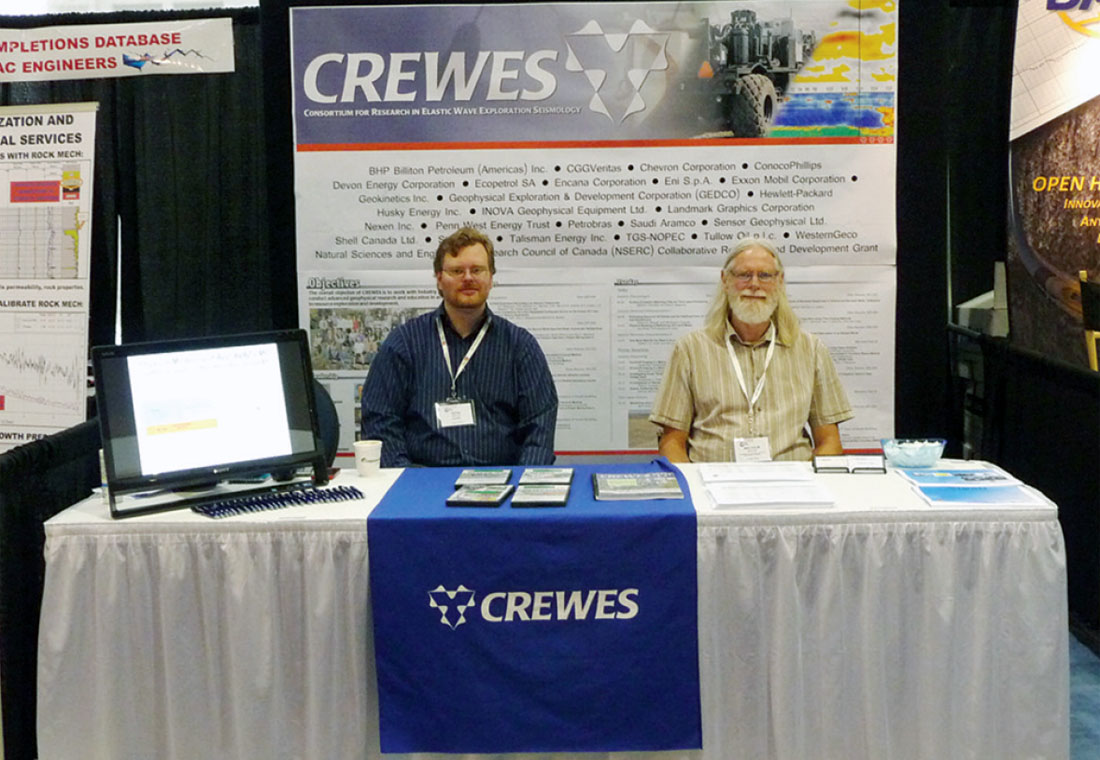
What are some of the continuing challenges being faced by CREWES and how is it gearing up to address them?
[Rob]: The energy sector, and with it geosciences, is cyclical. Applied geophysics at the university attempts to “ride out” the variations and maintain a vibrant program. With this, we endeavor to excite student enthusiasm for geophysics. This is somewhat based on external factors as career opportunities, new technologies, exotic applications, and public perceptions.
The problems in geophysics are getting harder – much of the easy analysis is done and many of the targets are smaller, more subtle, deeper, tighter, more complex, or in hostile areas. There’s lots of sunrise work to be done.
[Don]: Sustained funding will always be our greatest challenge. Sponsors have to renew every year, so we need continued high-quality output every year to justify continued sponsorship to their managers. This can raise the stress level of managing both short-term and long-term research project, as discussed in the previous section. Recent changes with the University regarding research income overhead will impact our research dollars from industry, but we are working hard to build this new model into our business plans.
[Gary]: Our greatest challenges in the next two years will not be scientific but rather financial. We are at the end of our current CRD grant from NSERC and will be reapplying shortly. This latter point refers to a grant that currently provides 1/3 of our total income and which will end in June 2014. We will be reapplying and the continued support of our industry partners will play a vital role in this.











Share This Interview